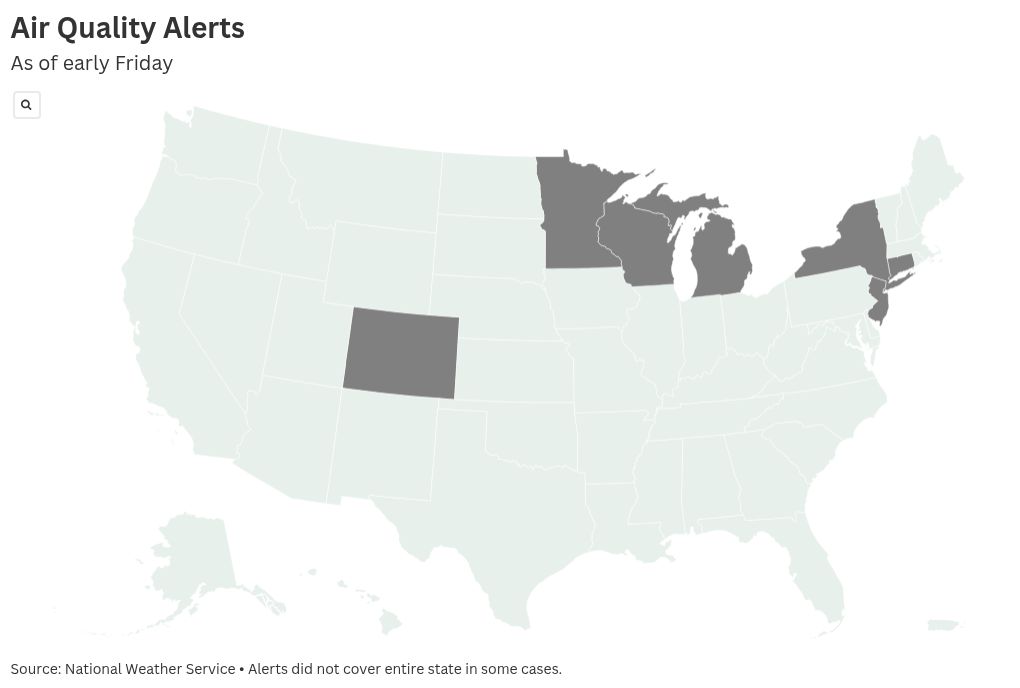National Weather Service (NWS) air quality alerts covered numerous U.S. states early on Friday due to both particle and ozone pollution, authorities cautioning residents over potential health effects.
Why It Matters
The Environmental Protection Agency (EPA) warns that exposure to ozone may irritate the respiratory tract, cause airway inflammation, and aggravate existing conditions such as asthma, emphysema, and chronic bronchitis.
Regarding particle pollution, the EPA states that studies have linked exposure to a range of health effects, including respiratory symptoms such as coughing and wheezing, the development of asthma, and increased susceptibility to respiratory infections.
What To Know
In Michigan, air quality alerts spanned the majority of the state’s upper peninsula as well as a central portion of the southern peninsula due to Canadian wildfire smoke.
“It is recommended that, when possible, you avoid strenuous outdoor activities, especially those with heart disease and respiratory diseases like asthma,” the alert said. “Monitor for symptoms such as wheezing, coughing, chest tightness, dizziness, or burning in nose, throat, and eyes.”

The entirety of Minnesota was also under air quality alert early on Friday, prompted by the smoke from Canada’s Saskatchewan and Manitoba regions.
Sensitive groups were advised to avoid prolonged or heavy exertion, but local authorities also warned that some members of the general public could also experience health effects.
Likewise, most of Wisconsin had been issued an air quality alert over Canadian wildfire smoke.
“People with heart disease: Symptoms such as palpitations, shortness of breath, or unusual fatigue may indicate a serious problem. If you have any of these, contact your health care provider,” read an alert for the state.
In addition to the above, several New York, New Jersey and Connecticut counties were under air quality alert due to ozone pollution, which local authorities said could reach potentially unhealthy levels.
This included New York, Bronx, Kings, Queens, Richmond, Nassau, Suffolk, Westchester, and Rockland Counties in New York, as well as Fairfield, New Haven, Middlesex, and New London Counties in Connecticut.
An additional air quality alert was set to remain in force until 9 a.m. local time on Friday for Colorado’s Mesa County due to nearby wildfires. The Turner Gulch fire burning in the county had reached 17,747 acres and was 45 percent contained as of early Friday, according to a map from nonprofit Watch Duty.
What People Are Saying
NWS Green Bay, Wisconsin said on X, Thursday: “An Air Quality Advisory has been issued until 11 p.m. Friday, but primarily for Friday due to smoke from fires in Canada becoming surface based and causing some air quality concerns for sensitive groups.”
AccuWeather meteorologist Brandon Buckingham told Newsweek previously: “Ozone is a secondary pollutant, meaning it’s not emitted directly from sources, but is formed through chemical reactions. These reactions require sunlight and higher temperatures, making warmer months more prone to ozone formation. When air is stagnant, pollutants don’t get dispersed, allowing ozone to build up to unhealthy levels.”
What Happens Next
The NWS issues regular forecast updates on its website.
The post Warning Issued For Millions To Monitor Palpitations, Shortness of Breath appeared first on Newsweek.




